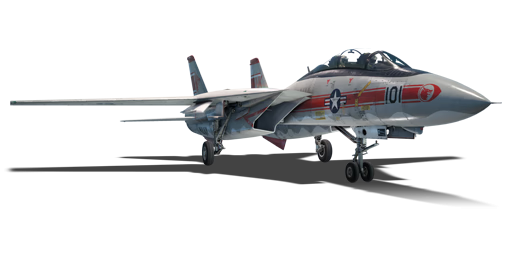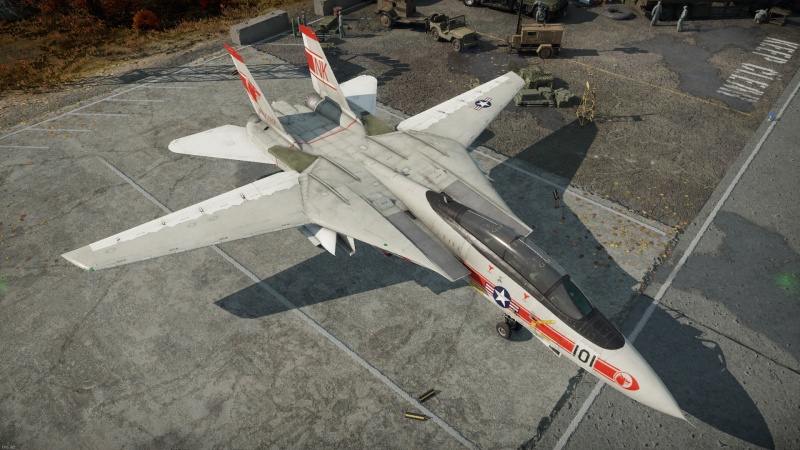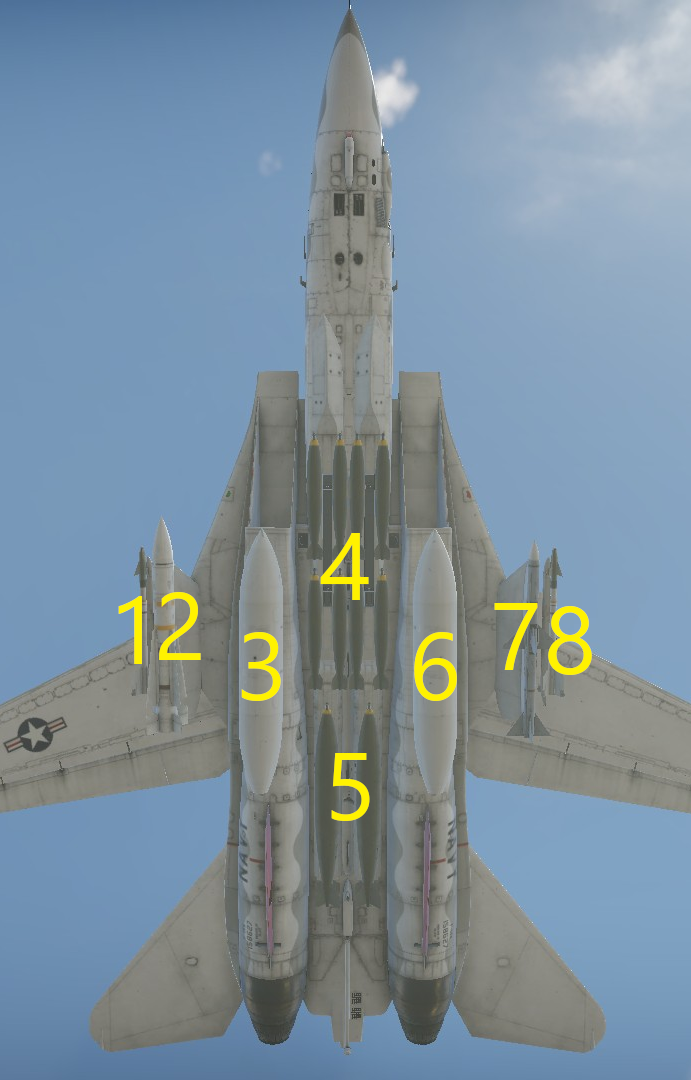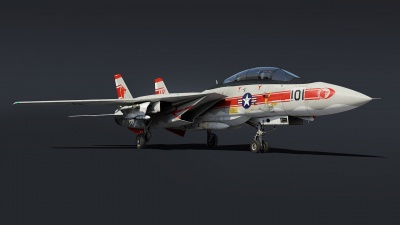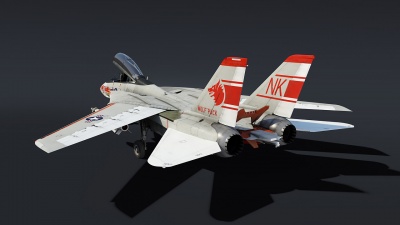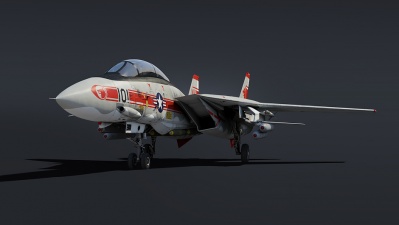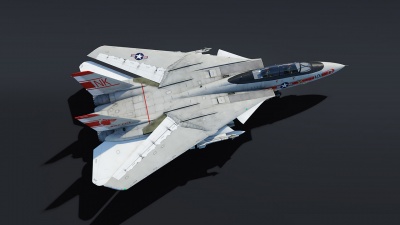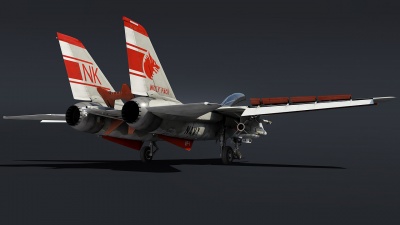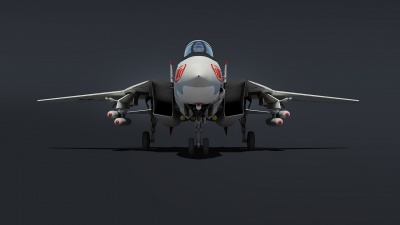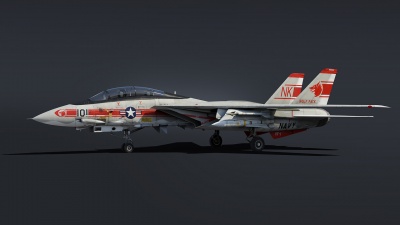Difference between revisions of "F-14A Early"
Colok76286 (talk | contribs) (Edits) |
R_nminbiY_n (talk | contribs) (LG_Kite72964's edit a few days ago removed everything after the pros and cons, added back the bits that weren't already re-added) |
||
| Line 230: | Line 230: | ||
== History == | == History == | ||
<!-- ''Describe the history of the creation and combat usage of the aircraft in more detail than in the introduction. If the historical reference turns out to be too long, take it to a separate article, taking a link to the article about the vehicle and adding a block "/History" (example: <nowiki>https://wiki.warthunder.com/(Vehicle-name)/History</nowiki>) and add a link to it here using the <code>main</code> template. Be sure to reference text and sources by using <code><nowiki><ref></ref></nowiki></code>, as well as adding them at the end of the article with <code><nowiki><references /></nowiki></code>. This section may also include the vehicle's dev blog entry (if applicable) and the in-game encyclopedia description (under <code><nowiki>=== In-game description ===</nowiki></code>, also if applicable).'' --> | <!-- ''Describe the history of the creation and combat usage of the aircraft in more detail than in the introduction. If the historical reference turns out to be too long, take it to a separate article, taking a link to the article about the vehicle and adding a block "/History" (example: <nowiki>https://wiki.warthunder.com/(Vehicle-name)/History</nowiki>) and add a link to it here using the <code>main</code> template. Be sure to reference text and sources by using <code><nowiki><ref></ref></nowiki></code>, as well as adding them at the end of the article with <code><nowiki><references /></nowiki></code>. This section may also include the vehicle's dev blog entry (if applicable) and the in-game encyclopedia description (under <code><nowiki>=== In-game description ===</nowiki></code>, also if applicable).'' --> | ||
| + | === Early Development === | ||
| + | In 1967, the U.S. Navy wanted a long-range fleet defence fighter to boost their naval plane capabilities with the "VFX" program. The USN first started with a redesigned F-111 Aardvark named the F-111B (basically an F-111 designed around the TF30 engine and AIM-54 Phoenix missiles), they soon found out that the F-111 was too big for practical reasons so the F-111B plan never came to fruition. Fast forward to 1969, the USN gave the contract to Grumman to build the new fleet defence fighter named the F-14 Tomcat, its first variants were built around the TF30 engines found on the F-111B and to use the AN/AWG-9 radar set and the airframe was specifically built to carry the AIM-54 Phoenix missile. | ||
| + | |||
===[[wt:en/news/7705-development-f-14a-tomcat-into-the-danger-zone-en|Devblog]]=== | ===[[wt:en/news/7705-development-f-14a-tomcat-into-the-danger-zone-en|Devblog]]=== | ||
In 1968, five aircraft building companies entered the Pentagon's competition for a new carrier-based interceptor fighter. The commission's preference was given to Grumman's design, a twin-engine jet fighter with a variable-swept wing. Work on the F-14A fighter began in February 1969, and in December of the next year, the new aircraft took her maiden flight. The main weapon of the F-14A was the AIM-54 Phoenix long-range missiles controlled by the newest to date weapon control system. Instead of building prototypes, Grumman immediately switched to the production of an experimental series, and already on December 31, 1972, the first batch of jet fighters were put into service with the VF-124 Fleet Replacement Squadron . Pilot training took place on the deck of the USS Enterprise aircraft carrier, and during the withdrawal of US troops from Vietnam, combat sorties were also made from the deck. In total 557 F-14A fighters were delivered to the US Navy until 1987, and another 80 aircraft were built for Iran. Tomcats were used in all military conflicts where US aircraft took part until the very decommissioning. Iranian F-14s took an active part in the Iran-Iraq war, scoring dozens of air kills. | In 1968, five aircraft building companies entered the Pentagon's competition for a new carrier-based interceptor fighter. The commission's preference was given to Grumman's design, a twin-engine jet fighter with a variable-swept wing. Work on the F-14A fighter began in February 1969, and in December of the next year, the new aircraft took her maiden flight. The main weapon of the F-14A was the AIM-54 Phoenix long-range missiles controlled by the newest to date weapon control system. Instead of building prototypes, Grumman immediately switched to the production of an experimental series, and already on December 31, 1972, the first batch of jet fighters were put into service with the VF-124 Fleet Replacement Squadron . Pilot training took place on the deck of the USS Enterprise aircraft carrier, and during the withdrawal of US troops from Vietnam, combat sorties were also made from the deck. In total 557 F-14A fighters were delivered to the US Navy until 1987, and another 80 aircraft were built for Iran. Tomcats were used in all military conflicts where US aircraft took part until the very decommissioning. Iranian F-14s took an active part in the Iran-Iraq war, scoring dozens of air kills. | ||
| Line 263: | Line 266: | ||
* [[wt:en/news/7705-development-f-14a-tomcat-into-the-danger-zone-en|[Devblog] F-14A Tomcat: Into the Danger Zone!]] | * [[wt:en/news/7705-development-f-14a-tomcat-into-the-danger-zone-en|[Devblog] F-14A Tomcat: Into the Danger Zone!]] | ||
| + | {{Template:AirManufacturer Grumman}} | ||
{{USA jet aircraft}} | {{USA jet aircraft}} | ||
Revision as of 00:45, 19 June 2022
Contents
Description
The F-14A Tomcat (Early) is a rank VIII American jet fighter with a battle rating of 12.3 (AB/SB) and 12.7 (RB). It was introduced in Update "Danger Zone".
General info
Flight performance
Describe how the aircraft behaves in the air. Speed, manoeuvrability, acceleration and allowable loads - these are the most important characteristics of the vehicle.
| Characteristics | Max Speed (km/h at _,___ m) |
Max altitude (metres) |
Turn time (seconds) |
Rate of climb (metres/second) |
Take-off run (metres) | |||
|---|---|---|---|---|---|---|---|---|
| AB | RB | AB | RB | AB | RB | |||
| Stock | ___ | ___ | 16764 | __._ | __._ | __._ | __._ | ___ |
| Upgraded | ___ | ___ | __._ | __._ | __._ | __._ | ||
Details
| Features | |||||
|---|---|---|---|---|---|
| Combat flaps | Take-off flaps | Landing flaps | Air brakes | Arrestor gear | Drogue chute |
| _ | _ | _ | _ | _ | _ |
| Limits | ||||||
|---|---|---|---|---|---|---|
| Wings (km/h) | Gear (km/h) | Flaps (km/h) | Max Static G | |||
| Combat | Take-off | Landing | + | - | ||
| 0 | 518 | ___ | ___ | ___ | ~__ | ~__ |
| Optimal velocities (km/h) | |||
|---|---|---|---|
| Ailerons | Rudder | Elevators | Radiator |
| < ___ | < ___ | < ___ | N/A |
Engine performance
| Engine | Aircraft mass | |||||
|---|---|---|---|---|---|---|
| Engine name | Number | Basic mass | Wing loading (full fuel) | |||
| Pratt & Whitney TF30-P-412A | 2 | _,___ kg | ___ kg/m2 | |||
| Engine characteristics | Mass with fuel (no weapons load) | Max Takeoff Weight | ||||
| Weight (each) | Type | _m fuel | __m fuel | __m fuel | ||
| ___ kg | ___ | _,___ kg | _,___ kg | _,___ kg | _,___ kg | |
| Maximum engine thrust @ 0 m (RB/SB) | Thrust to weight ratio @ 0 m (___%/WEP) | |||||
| Condition | 100% | ___%/WEP | _m fuel | __m fuel | __m fuel | MTOW |
| Stationary | ___ kgf | ___ kgf | _.__ | _.__ | _.__ | _.__ |
| Optimal | ___ kgf (_ km/h) |
___ kgf (_ km/h) |
_.__ | _.__ | _.__ | _.__ |
Survivability and armour
Examine the survivability of the aircraft. Note how vulnerable the structure is and how secure the pilot is, whether the fuel tanks are armoured, etc. Describe the armour, if there is any, and also mention the vulnerability of other critical aircraft systems.
Modifications and economy
Armaments
| Ballistic Computer | |||
|---|---|---|---|
| CCIP (Guns) | CCIP (Rockets) | CCIP (Bombs) | CCRP (Bombs) |
| |
|
|
|
Offensive armament
The F-14A Early is armed with:
- A choice between two presets:
- 1 x 20 mm M61A1 cannon, cheek-mounted (676 rpg)
- 1 x 20 mm M61A1 cannon + 60 x countermeasures
Suspended armament
The F-14A Early can be outfitted with the following ordnance presets:
- Without load
- 2 x AIM-9D Sidewinder missiles
- 4 x AIM-9D Sidewinder missiles
- 4 x AIM-9G Sidewinder missiles
- 4 x AIM-9H Sidewinder missiles
- 6 x AIM-7E Sparrow missiles
- 6 x AIM-7F Sparrow missiles
- 6 x AIM-54A Phoenix missiles
- 14 x 250 lb LDGP Mk 81 bombs (3,500 lb total)
- 14 x 500 lb LDGP Mk 82 bombs (7,000 lb total)
- 4 x 1,000 lb LDGP Mk 83 bombs (4,000 lb total)
- 4 x 2,000 lb LDGP Mk 84 bombs (8,000 lb total)
- 16 x Zuni Mk32 Mod 0 ATAP rockets
Custom loadout options
| 1 | 2 | 3 | 4 | 5 | 6 | |||
|---|---|---|---|---|---|---|---|---|
| 250 lb LDGP Mk 81 bombs | 8* | 6 | ||||||
| 500 lb LDGP Mk 82 bombs | 8* | 6 | ||||||
| 1,000 lb LDGP Mk 83 bombs | 2* | 2 | ||||||
| 2,000 lb LDGP Mk 84 bombs | 2*† | 2 | ||||||
| Zuni Mk32 Mod 0 ATAP rockets | 8 | 8 | ||||||
| AIM-7E Sparrow missiles | 1 | 2 | 1, 2* | 1 | ||||
| AIM-7F Sparrow missiles | 1 | 2 | 1, 2* | 1 | ||||
| AIM-9D Sidewinder missiles | 1 | 1 | 1 | 1 | ||||
| AIM-9G Sidewinder missiles | 1 | 1 | 1 | 1 | ||||
| AIM-9H Sidewinder missiles | 1 | 1 | 1 | 1 | ||||
| AIM-54A Phoenix missiles | 1 | 2* | 2† | 1 | ||||
| * Use of dual Sparrow missiles on hardpoint 4 prevents use of the marked options on hardpoint 3 † The AIM-54A Phoenix missiles on hardpoint 4 cannot be carried in conjunction with 2,000 lb LDGP Mk 84 bombs on hardpoint 3 | ||||||||
Usage in battles
Describe the tactics of playing in the aircraft, the features of using aircraft in a team and advice on tactics. Refrain from creating a "guide" - do not impose a single point of view, but instead, give the reader food for thought. Examine the most dangerous enemies and give recommendations on fighting them. If necessary, note the specifics of the game in different modes (AB, RB, SB).
Pros and cons
Pros:
- Excellent turn rate despite being a large and heavy plane
- 60 countermeasures provides excellent ability to ward off missiles
- Lethal M61 Vulcan due to its fast fire rate and projectile velocity
- Can carry up to 8 missiles maximum, with options of AIM-7s, AIM-9s, and AIM-54 for versatile use
- The AIM-54 has insane range (100 km max) and its rocket booster lasts for a very long time, and it's also an ARH (Active radar homing) missile
- Very effective dogfighter at any speeds with its variable wing sweep thus being one of the best energy retaining jet fighters
- Variable swept wings can help plane accelerate fast when it's swept back and also good when slow with the wings are expanded
- The top speed of this plane is very high (can cap out at 1500 km/h IAS at sea level)
- Effective bomb loadouts also makes this plane good at ground pounding
- Multi-mode radar makes it effective at any situation (The TWS mode makes the AIM-54 rather potent)
- The brand new AIM-9H has much better flare resistance than previous AIM-9s (such as the G variant or J)
Cons:
- Big plane, leading to the F-14A being a very easy target to hit
- The fuel burning is otherworldly fast, requires carrying a lot that can hamper the plane's maneuverability
- Massive wing and fuselage fuel tanks makes it so if the plane gets hit anywhere, it would most definitely go down in a fireball
- Cannot pull sustained Gs when above 1000 km/h IAS (11-13 Gs) or the wings would rip
- The engine heat signature is very large, making plane more vulnerable to IR missiles, especially when the pilot is distracted
- The AIM-54's rocket motor lasts for a very long time making it very easy to see and dodge
History
Early Development
In 1967, the U.S. Navy wanted a long-range fleet defence fighter to boost their naval plane capabilities with the "VFX" program. The USN first started with a redesigned F-111 Aardvark named the F-111B (basically an F-111 designed around the TF30 engine and AIM-54 Phoenix missiles), they soon found out that the F-111 was too big for practical reasons so the F-111B plan never came to fruition. Fast forward to 1969, the USN gave the contract to Grumman to build the new fleet defence fighter named the F-14 Tomcat, its first variants were built around the TF30 engines found on the F-111B and to use the AN/AWG-9 radar set and the airframe was specifically built to carry the AIM-54 Phoenix missile.
Devblog
In 1968, five aircraft building companies entered the Pentagon's competition for a new carrier-based interceptor fighter. The commission's preference was given to Grumman's design, a twin-engine jet fighter with a variable-swept wing. Work on the F-14A fighter began in February 1969, and in December of the next year, the new aircraft took her maiden flight. The main weapon of the F-14A was the AIM-54 Phoenix long-range missiles controlled by the newest to date weapon control system. Instead of building prototypes, Grumman immediately switched to the production of an experimental series, and already on December 31, 1972, the first batch of jet fighters were put into service with the VF-124 Fleet Replacement Squadron . Pilot training took place on the deck of the USS Enterprise aircraft carrier, and during the withdrawal of US troops from Vietnam, combat sorties were also made from the deck. In total 557 F-14A fighters were delivered to the US Navy until 1987, and another 80 aircraft were built for Iran. Tomcats were used in all military conflicts where US aircraft took part until the very decommissioning. Iranian F-14s took an active part in the Iran-Iraq war, scoring dozens of air kills.
Media
- Images
See also
Links to the articles on the War Thunder Wiki that you think will be useful for the reader, for example:
- reference to the series of the aircraft;
- links to approximate analogues of other nations and research trees.
External links
| Grumman Aircraft Engineering Corporation | |
|---|---|
| Aircraft | |
| Fighters | |
| F3F | F3F-2 · Galer's F3F-2 |
| F4F Wildcat | F4F-3 · F4F-4 |
| XF5F Skyrocket | XF5F · XP-50 |
| F6F Hellcat | F6F-5 · F6F-5N |
| F7F Tigercat | F7F-1 · F7F-3 |
| F8F Bearcat | F8F-1 · F8F-1B |
| Jet Fighters | |
| F9F Panther/Cougar | F9F-2 · F9F-5 · F9F-8 |
| F-11 Tiger | F11F-1 |
| F-14 Tomcat | F-14A Early · F-14B |
| Jet Strike Aircraft | |
| A-6 Intruder | A-6E TRAM |
| Bombers | TBF-1C |
| Export | ▄Martlet Mk IV · ▄F6F-5 · ▄F6F-5N · ▄F8F-1B · ▄Avenger Mk II · ▄Hellcat Mk II |
| ▄F-14A IRIAF | |
| Naval Vehicles | |
| Patrol Gunboat Hydrofoil (PGH) | USS Flagstaff |
| USA jet aircraft | |
|---|---|
| Fighters | |
| F9F | F9F-2 · F9F-5 · F9F-8 |
| F-80 | F-80A-5 · F-80C-10 |
| F-84 | F-84B-26 · F-84F · F-84G-21-RE |
| F-86 | F-86A-5 · F-86F-25 · F-86F-2 · F-86F-35 |
| F-89 | F-89B · F-89D |
| F-100 | F-100D |
| F-104 | F-104A · F-104C |
| F-4 | F-4C Phantom II · F-4E Phantom II · F-4J Phantom II · F-4S Phantom II |
| F-5 | F-5A · F-5C · F-5E · F-20A |
| F-8 | F8U-2 · F-8E |
| F-14 | F-14A Early · ▄F-14A IRIAF · F-14B |
| F-15 | F-15A · F-15C MSIP II · F-15E |
| F-16 | F-16A · F-16A ADF · F-16C |
| Other | P-59A · F2H-2 · F3D-1 · F3H-2 · F4D-1 · F11F-1 |
| Strike Aircraft | |
| FJ-4 | FJ-4B · FJ-4B VMF-232 |
| A-4 | A-4B · A-4E Early |
| A-7 | A-7D · A-7E · A-7K |
| AV-8 | AV-8A · AV-8C · AV-8B Plus · AV-8B (NA) |
| A-10 | A-10A · A-10A Late · A-10C |
| F-111 | F-111A · F-111F |
| Other | A-6E TRAM · F-105D · F-117 |
| Bombers | |
| B-57 | B-57A · B-57B |


